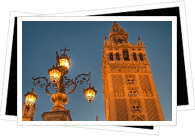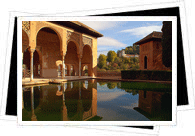
Considering Spain was ruled for - in some parts - up to 800 years by the Moors, it's no surprise that lasting remnants of Spain's Islamic past are present in everything from gastronomy to music, language and architecture. Even when the Islamic empire finally succumbed to the Reconquest, the dazzling architectural forms and styles lived on for centuries.
Islamic architecture is considered to be Spain's most captivating architectural trend and certainly gives the country an exotic edge- especially considering the fact that Islamic architecture is the only style that Spain doesn't share with the rest of Europe!

Along with the closely linked Mudéjar style (architecture created by Muslims under Christian rule), Islamic architecture is one of refined sophistication, sumptuous decoration and peaceful harmony. Keep an eye out for elegant lobed and horseshoe arches, tranquil courtyards, ornate carvings, beautiful tile work and the repetition of geometric and nature-based motifs.
Another signature element of Islamic architecture is the integration of nature. Light, water and vegetation are masterfully incorporated into palaces, homes and mosques and serve both practical and aesthetic purposes. Especially given that Islamic architecture traditionally hails from a culture based in arid desert lands, you are bound to see lush gardens gracing courtyards, filtered light creating geometric patterns across the floor and tranquil fountains and reflecting pools both indoors and outdoors.
In the realm of urban planning, dive into the quaint Islamic quarters in many of Andalucía's most emblematic cities, where white-washed buildings were constructed practically right on top of each other on narrow streets. The Moors sure knew how to beat the heat, as this manner of construction, along with the incorporation of shady courtyards, avoids direct sunshine and keeps these Islamic quarters comfortable and cool.
Following the Reconquest, Islamic architecture and design lived on, first through the Mudéjar style and later through Gothic, Renaissance and Baroque styles. The Islamic influence then died out for a bit until the ever creative 20th century Moderniste architects, such as Antoni Gaudí, brought it back with a force.